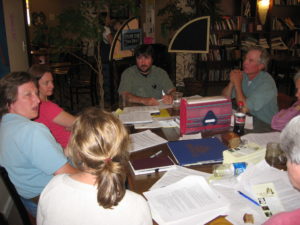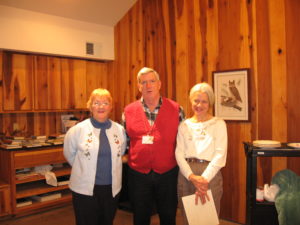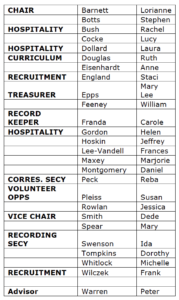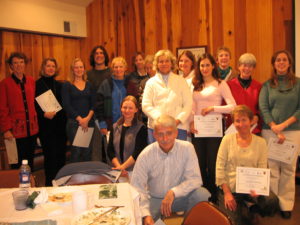By Ida Swenson, January 2017
For many in the Charlottesville area, we first heard of the Master Naturalists at a meeting of the Natural History Roundtable at the Ivy Creek Natural Area Education Building in the fall of 2005. Dede Smith, chair and host of the meeting, introduced a new employee of Virginia Tech, Michelle Prysby, who had been hired that October to develop a state wide cadre of volunteers. Dede and Michelle were not only providing information, but seeking people who would be willing to help develop a local chapter of the new organization which would be called the Virginia Master Naturalists.
In March of 2006, a meeting was set up to begin the process of organization. Invited to the meeting were Dede, Peter Warren (Horticultural agent for the Albemarle County Cooperative Extension), LoriAnne Barnett, Susan Pleiss, Mary Lee Epps (Active volunteer for Ivy Creek Natural Area), Anne Mallek (Virginia Museum of Natural History), and myself (Education Contractor for the Rivanna Conservation Society). We soon were joined by Carol Franda and Ruth Douglas. We had a chapter organization flow chart from the State as well as a flow chart for certification. Ruth and Susan went to a statewide meeting about the new organization. We also were given draft models for developing our By-laws and Operating Handbook as well as a syllabus of what should be covered in our trainings. We established ourselves as the coordinating committee for the forming of the new chapter. And the heavy lifting began.
By the end of July, just four months later we had for submission to the State office:
- A chapter name and ‘territory’
- Draft Bylaws
- Draft Operating Handbook
- Syllabus for our fall, 2006, training class.
- Survey of prospective members
- Application form
- Application cover letter
- List of possible projects to be approved
- Post office box
The Post office box was an adventure unto itself. Susan Pleiss went to sign us up for one. She filled out the form and when she passed it to the clerk, he asked, “Oh, are you nudists?” We all got a big laugh out of that, but to this day occasionally folks apply to be members of our website, and when they are vetted on facebook it turns out they are ‘naturists’. (The rest of us don’t want to scare the wildlife!!!)
Organizing the very first training class was a monumental task but only after graduating a class could we truly become a chartered chapter of the Virginia Master Naturalists. Much work and thought was devoted to developing the syllabus for the first training. Fortunately, our group included people very familiar with great resources for instructors for the class – Michelle Prysby
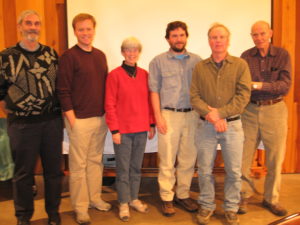
Lou Verner of DWR, Peter Warren, Ruth Douglas, Sam Austin, Tom Biggs and John Murphy were among the stellar teachers lined up for the class. Tom Direauff and Dan Bieker were among the field trip instructors. Not only did we have to line up the class choices and speakers, but we needed a set of readings developed “from scratch”. Mary Lee Epps, with some assistance, not only developed the list of readings but also took over the ordering of materials as our new treasurer. She writes, “The closest thing we had to a “text” was the Peterson Guide to Eastern Forests while I was organizing the readings. Dede originally recommended this. Also, I had a big stack of possible readings that the State Co-ordinating Committee (or whatever they were called) had put together, which I’m pretty sure I got from Michelle. I sorted through these and chose which ones to include on the initial syllabus.”
At the first class meeting on September 12, we had 18 people signed up. In August, we not only had to collect and review the applications, gather all the needed materials, but also write an acceptance letter and welcome, write Project Proposals to be approved by the coordinating committee, and collate the extensive notebook materials. It was a monumental task, but in the end, our first training class began and now we had more of a volunteer base to develop our fledgling chapter.
As the class progressed, the curriculum committee continued to work to develop a required final assessment and the decision was made to also offer a practical exam. Ida and others wrote the final which consisted of 35 multiple choice and short answer questions. She and Mary Lee also developed a practical exam to assess skills. A volunteer timesheet was developed to report hours to our new timekeeper, Carol Franda. When the end of the class came, there were three folks with enough volunteer and advanced training hours to be certified: Mary Lee Epps, Frank Wilczek, and Ida Swenson. The class, with office or committee volunteers, is listed below. Peter Warren was our chapter advisor.
And being brash and bold, the new Board of Directors (as we were finally chartered!!) decided that we should have another training in the spring of 2007. This meant that even as we were developing, delivering, and grading the assessments for the class of 2006, we were preparing for a new class!!!
At the end of our second class, we were exhausted by a year of heavy thinking and hard labor. We all looked at each other and said “Once a year is enough!!” We had a lot of revisions and improvements we wanted to implement, and that would take time and more thought. We were also active volunteers in other arenas than Master Naturalist administration and some of us had full time nine-to-five jobs. And so, the policy of one class a year began.
Being part of establishing the Rivanna Master Naturalists has been one of the most constructive things I have done. Over the past ten years, we trained a new class each year, 225 volunteers in all; over half are active volunteers. We have contributed over 55,000 hours of volunteer service. In 2015 alone, our education activities reached over 12,000 people.
And it has resulted in wonderful friends and co-workers. Most of us have at least one story about a memorable event that happened while we were volunteering. (Don’t get me started!!) And we have had a great time together. Special events from hikes, to paddles, to advanced trainings, to state conferences have added richness to our time together. Over and above all of that, we have a wonderful sense of giving back, and of preserving the natural heritage we all love.

